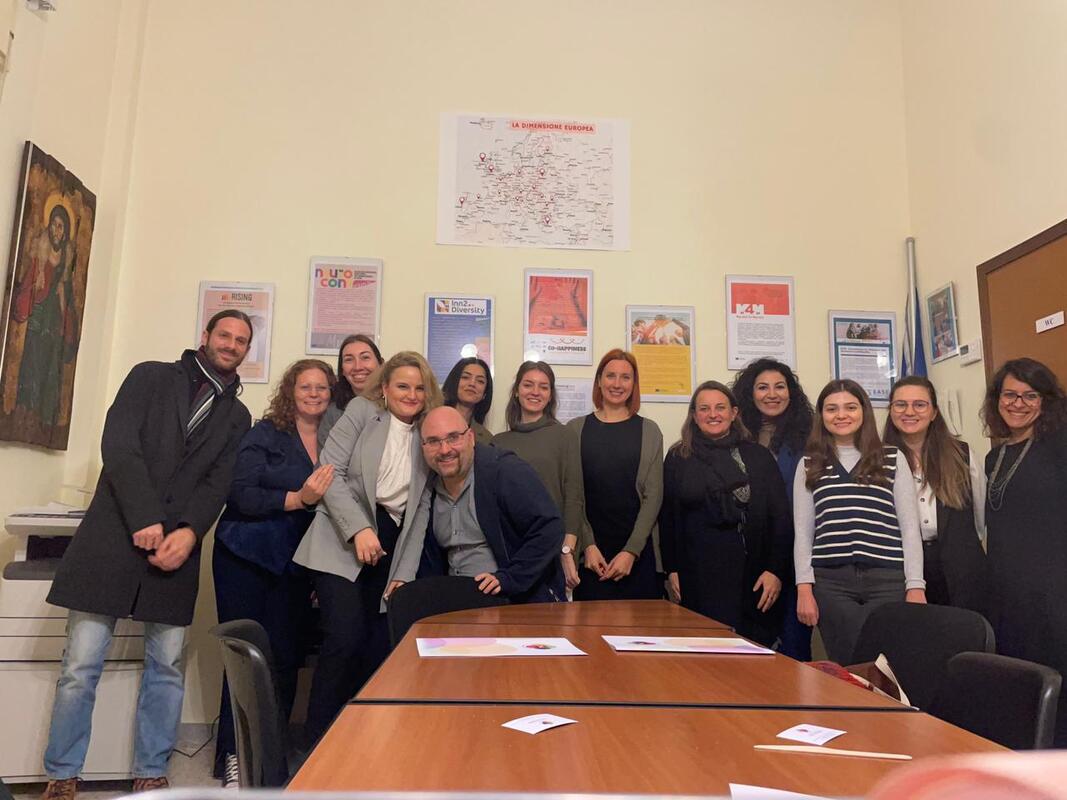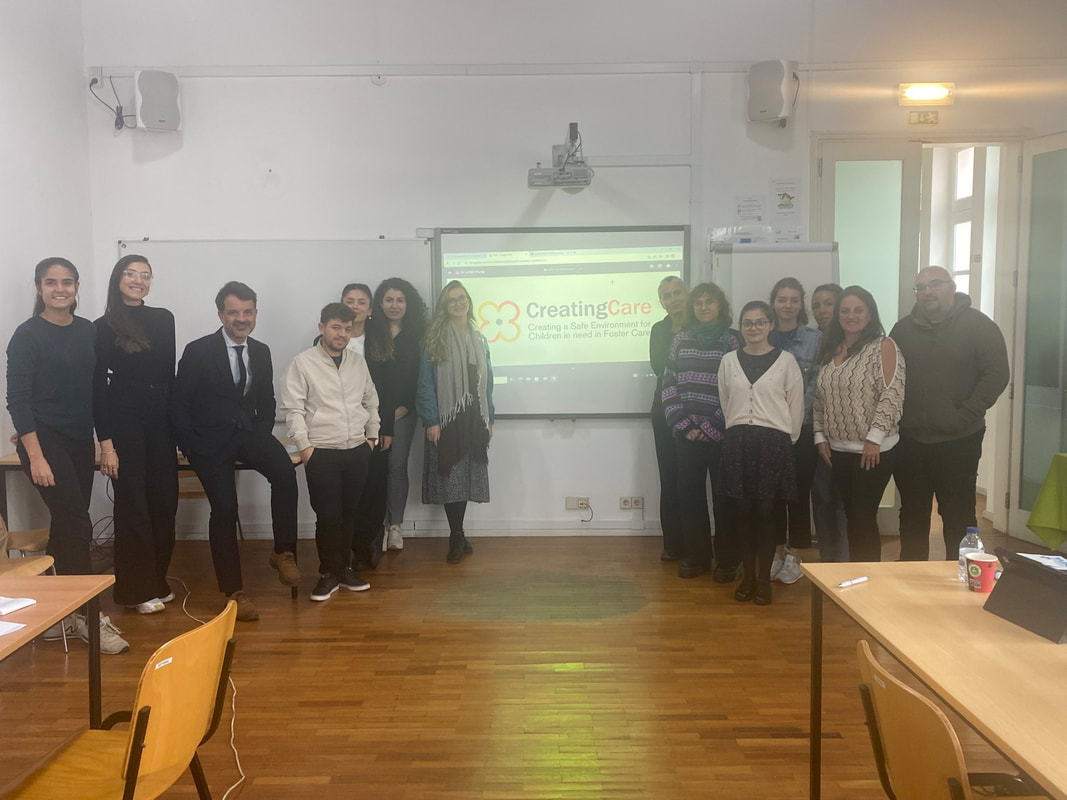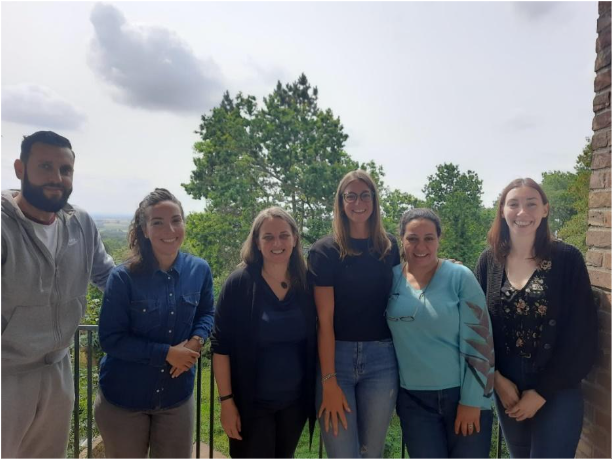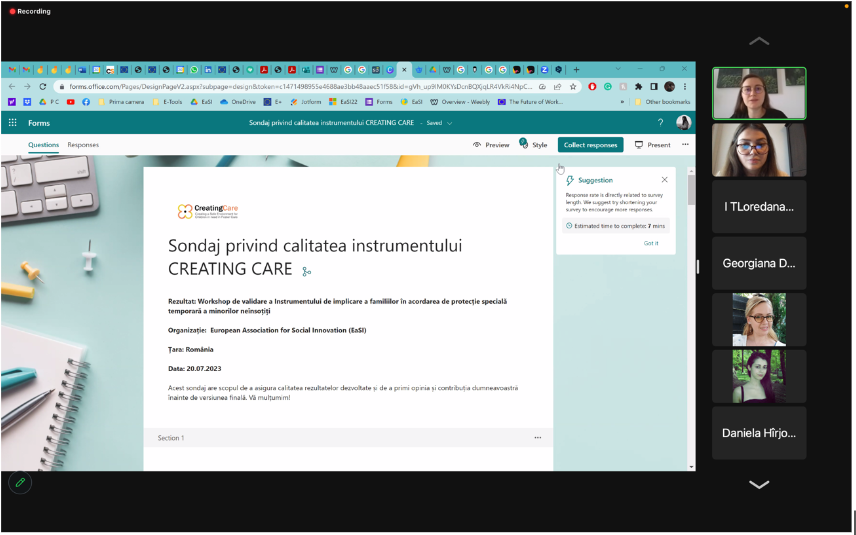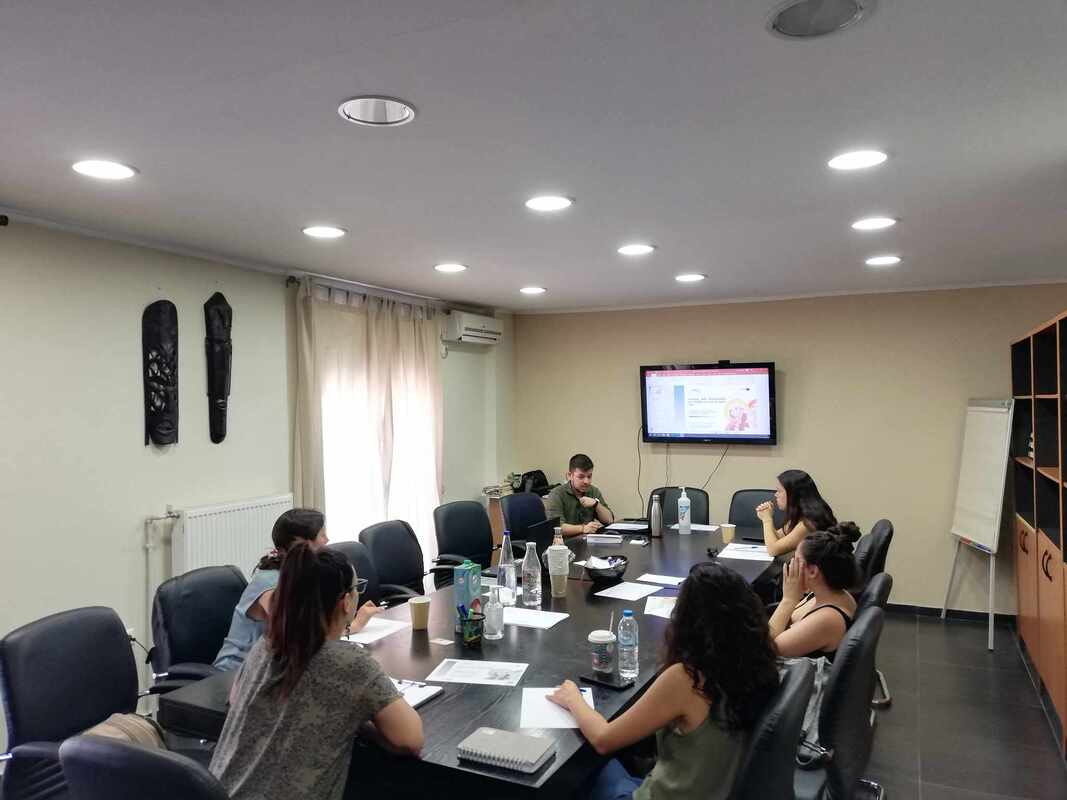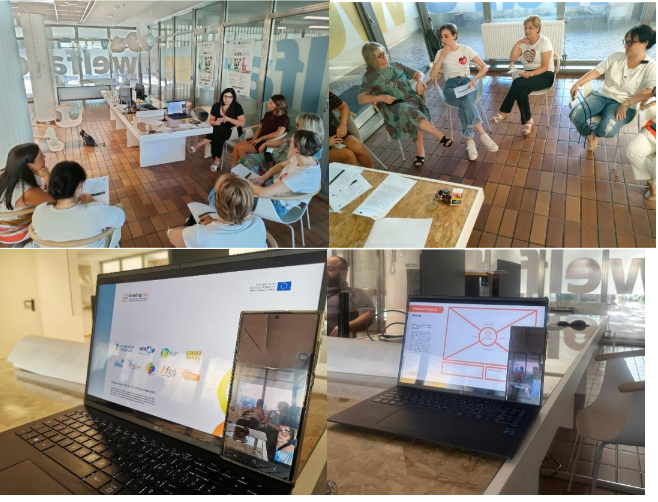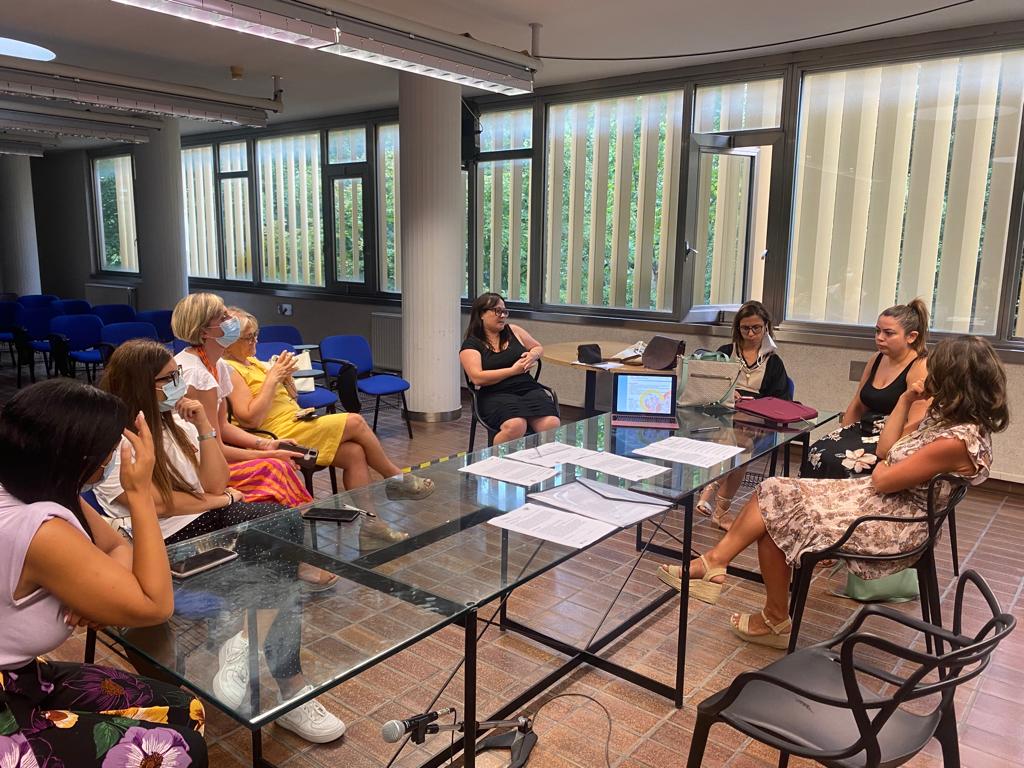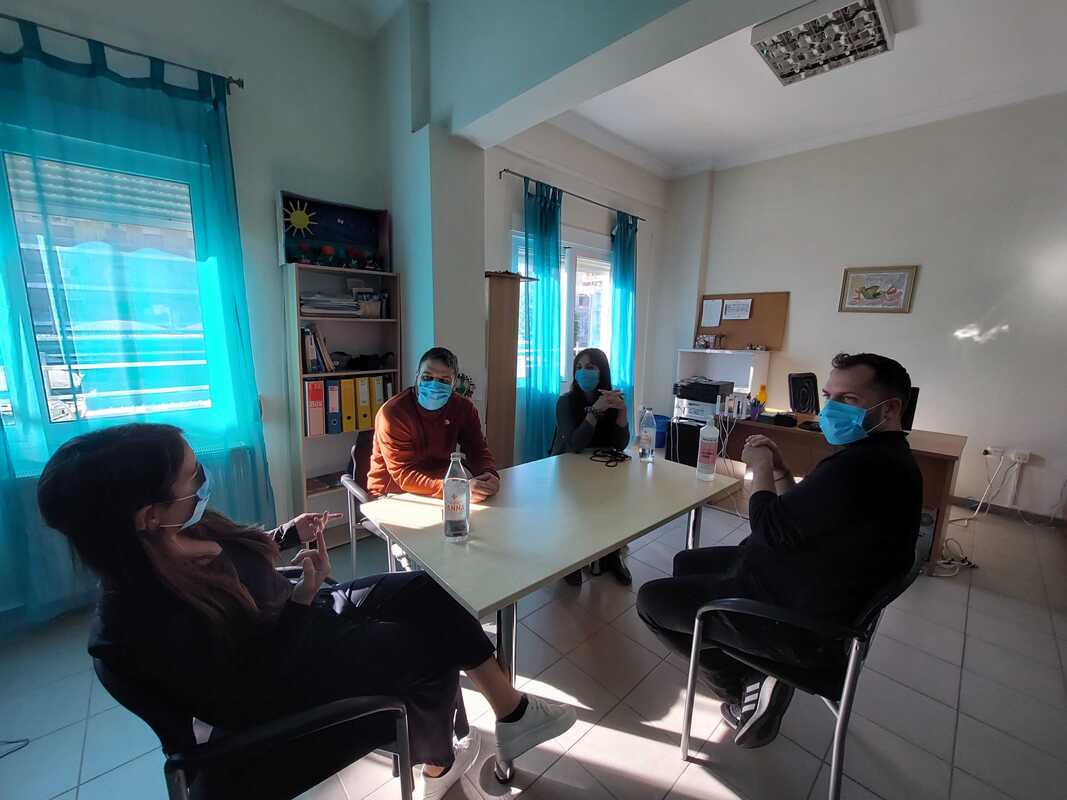|
On the 24th-25th of January, the third Transnational Project Meeting of the Creating Care project was held in Cerignola, Italy.
The nine partner organisations had productive discussions regarding the work on the project results and the progress achieved so far. So we are happy to inform you that the first two results of the project, Tool for Understanding Professionals' Perceptions and Experiences in terms of recruitment and communication with foster families and Tool for Understanding Foster families' needs, perceptions, and experiences, have been finalized and the final reports will soon be available on the website. Further on, we have started working on the next two outputs Family engagement tool and Training course on communicating skills and strategies in the process of recruiting foster families.
0 Comments
The Creating Care partners gathered in Lisbon, Portugal on the 24th and 25th of October for the fourth Transnational Project Meeting.
The discussions were productive and led to setting out the next steps to be taken towards finalizing the two project deliverables:
We are also glad to inform you that work has started on the last project result, the App for foster families. stay tuned for more updates on the project. Photo by Michael Burrows Our third PR intends to develop a practical tool to help professionals to engage all families and to raise awareness on the need of increasing the number of foster carers as a strategy towards deinstitutionalization. Based on the results obtained from PR1 and PR2, this tool will help professionals through comprehensive information and high-impact family engagement activities, to awaken social awareness and to encourage social solidarity and responsibility among all members of the community. So we put the tool to test and organised validation workshops with professionals. As you will see below, the tool was generally well received and the participants had valuable feedback and recommendations for the Creating Care partnership, which will help us improve and create a better result. FranceParticipants profile: 7 participants, specialized or educational educators, international project coordinators and an intern. Although these professionals do not work directly with foster families, they work with unaccompanied minors daily and are therefore familiar with their needs and their expectations of living with a foster family. The participants appreciated the workshop and the project, which they found very innovative. Regarding the tool, they recommended to include discussion on topics like: · Culture · Administrative procedures imposed on unaccompanied minors · Describe the advantages of hosting an unaccompanied minor and set limits The professionals think that this tool is very interesting and innovative and that they will be able to use it with the volunteer foster families with whom they already work. They think that the activities are fun and provide the keys to training foster families. However, they think that the topic of unaccompanied minors is not covered in sufficient depth in the tool. It would be interesting to add the points about unaccompanied minors and to talk about the professionals who will help support these foster families and young unaccompanied minors. RomaniaParticipants profile: 14 professionals, social workers, counsellors, psychologists, head of maternal assistance service. The overall impression is positive on the project as a whole. For the Family Involvement Tool, the professionals present were sceptical about the context in which it can be used, given that the institutions they come from already have protocols in place regarding communication and recruitment of foster families (maternal assistants). The feedback from completing the evaluation questionnaire reflects that the tool needs improvement particularly in clarifying the context in which it can be used by child protection professionals. Other comments to consider pointed out that the tool has an idealistic vision, the myths presented in the Myth Box activity are actually realities unfortunately, which represent real challenges for professionals. The main conclusion for the interpretation of the collected feedback is that the tool must have a clearer context of its use and a more accentuated component of awareness and communication. GreeceParticipants profile: 6 participants, 3 social workers & 3 psychologists. Overall, as strengths they highlighted the fact that the tool gathers enough and essential information that is not accessible elsewhere. As weaknesses they mentioned that they would like to see more practical examples of how to handle difficult cases that actually may occur in a foster family. Lastly, on improvements & suggestions, they mentioned that it would make the Tool even more holistic to mention «foster parent education support programmes” before and during fostering care that are available right now in the country and that always helps in projects like this (CreatingCare) to have public authorities participating in the development, as those are responsible on the subject in question and the information always starts from them. ItalyParticipants profile: 6, four social workers and two psychologists.
The overall assessment of the tool is positive. All participants agree that it is a user-friendly tool, the activities are intuitive, understandable and really easy to carry out. Regarding sustainability they said: "the tool goes straight to the point: raising awareness among families" "the tool responds perfectly to a need that we feel strongly, which is to involve potential foster families". Regarding feasibility and acceptability, the participants commented that "it is a challenge for potential foster parents; therefore, we must aim to solicit them"; "adaptable to every different cultural and social context". About the accuracy, some participants commented as follows: “It is essential that the tool is concrete, placed in the context and above all accurate, practical, not far from reality"; "the activities of the tool are beneficial for professionals and stakeholders"; "the tool is functional to the activity that we professionals we carry out". So far, the results of the theoretical research and practical observations show that in all partner countries there are more or less strict, legally binding criteria for recruitment and deployment, as well as governmental support measures, training and official audits when it comes to placing children in foster families. However, from the national brief studies of the project partners, gradual differences can also be identified, i.e. the national situation of foster families in the individual partner countries also has some specific features. Based on the results of the research of the individual partner organisations, a comparative analysis was carried out to identify the specific situation, the prerequisites for foster families and the institutions involved in the respective countries. In addition, further research was conducted to complement the individual studies and to make certain trends visible in a pan-European context. This includes the placement of unaccompanied refugee children, some of whom are traumatised, vulnerable children who find themselves in difficult and precarious life situations and need special protection. The study in general and the analysis of the results of the individual focus group discussions in particular show that there are different approaches with different emphases here. It also shows that some countries have recognised the specific problems of refugee children and are trying to develop perspectives to deal adequately with the children concerned. In some countries there seems to be rather a lack of awareness of the situation of unaccompanied refugee children. The evaluation and analysis of the interviews with the focus groups in the individual partner countries carried out here is therefore intended, on the one hand, to reflect on the theoretically gained insights from the perspective of professionals working in practice and to develop ideas on the extent to which these insights can be transferred into practice or whether they correspond to the practical working world. On the other hand, it is important to work out the commonalities and the national specificities, to draw conclusions for the future handling of foster children and foster parents and to design appropriate and future-oriented (training) education measures. From this point of view, it seems particularly important to prepare and enable professionals to deal with foster families, to recruit foster parents and to communicate with them as well as to include their interests, needs and expectations in the conceptual considerations without ignoring the reality of foster children's lives. Conceptually, the approach of thinking together both specific perspectives, i.e. the situation of foster families and foster children, and developing conceptual, holistic and individual profiles from this, seems to be a further step. As was emphasized in all focus groups in a special way, these considerations also include the reduction of prejudices and stereotypes in the public. In this sense, the project focuses on the inclusion of children at risk (with a special emphasis on unaccompanied children) and advocates for alternative forms of care such as foster families. In summary, three perspectives emerged from the work so far that characterize the foster care system in all partner countries. These are perspectives that will play a role in the development of modules and will be incorporated into the conception and design of training programmes: 1) Structural obstacles: Lack of or rigid, inflexible legislation; restrictive laws in the area of refuge; unnecessary bureaucratic hurdles; lack of cooperation between the institutions involved; insufficient training of foster parents; overwork of professionals; problems with authorisation procedures; lack of regular training, education and professional development. 2) Life-world aspects in connection with foster families and foster children: Focus on the reality of life of foster parents and foster children; respect for the respective situation of those involved; taking the needs and interests of those involved seriously; not losing sight of intercultural particularities; more insight into the reality of life of foster parents and foster children; relationship work. 3) Possibilities for intervention (best practices) and further ideas: Creation of an application tool containing all important information; Continuous family mediation; Participatory design of all processes; Sensitisation of the population; Creation of social awareness for the situation of children and families; Therapeutic care for traumatised children; Informal talks; Methods of trauma work; Concept of New Authorities (systemic approach); Case management approach focusing on the life situation of those involved. Only when the three aspects are thought of together can adequate intervention methods be developed and positive synergy effects achieved. This requires training modules that include the most important aspects of the intervention in the conceptual and methodological considerations: The first step is a holistic approach that marks the most important structural obstacles, makes the lifeworld perspectives of those involved visible and includes best practices in further conceptual considerations (integrative approach). Only then can appropriate individual profiles be developed depending on the situation. Another point that should accompany the entire processes is diversity and resource orientation both in institutional, theoretical and concrete work. This means that foster parents and foster children are not seen as victims of their living conditions but as experts of their own practice. Their ideas, perspectives and experiences are respected, acknowledged and integrated into the intervention. Images source: freepick.com
In addition to the first project outcome, the second project result of the Creating Care project is the development of a tool for analysing foster families' needs, perspectives, and experiences. With that in mind, we'd like to share some of the findings from the partners' focus groups with families and children. AustriaIn Austria, the interviews were conducted with individual families and children. The qualitative survey methods and the questions envisaged in the project were adapted to practice. What kind of obstacles do you face after becoming a foster family? Most of the families with whom interviews were held stated that they had had problems with the families of origin. There were many difficult situations that the foster families were confronted with and had to deal with, but were often not so easy. The interviews showed that most foster parents were afraid that the children might return to the family of origin at some point. This thought is very stressful for many families, even if the probability of a return is low. What are the benefits of being a foster family? In most interviews, the benefits mentioned are the children's bonds with the foster parents. Experiencing this process is emphasized as positive. The foster mother K. comments on this: "No matter whether bodily, adopted or in foster care - when you see a child for the first time, you know: we are now the world for this child. And it ours." FRANCEIn France, the focus groups were carried out with two foster families. The process of finding foster families who receive unaccompanied minors was not easy. In general, in France, young unaccompanied minors do not live with host families, whether they are volunteers or work for the department; this is rare and often informal. What kind of obstacles do you face after becoming a foster family ? Family 1 : “It is always quite difficult when the path is not a long one after 18 years (no recognition, no residence title...). Difficulties also when a young person comes from a "rich" family and feels superior to others. Family 2 : “The lack of availability because I work and take into account the other members of the family” What are the benefits of being a foster family ? Family 1 : “To have an open mind, to exchange on different values, customs from one country to another... It's very enriching !” Family 2 : “Meetings, cultural exchanges, becoming a reference point for the rest of their journey...” Czech RepublicIn the Czech Republic the discussions with foster families revealed that there are pleanty of obstacles professionals in the foster care system and foster parents and children face. Among them we mention:
Complementary to the first project result, the second result of the Creating Care project consists in designing a tool for understanding foster families’ needs, perceptions and experiences. With that in mind we would like to share some of the findings of the focus groups the partners have been conducting with families and children. ItalyThe approach: The first part of the project included a focus group with experts and professionals from the foster care system, during which we could listen to the point of view of those working in the field. The second focus group addressed foster families and children to investigate and learn about their experiences, difficulties and points of view. We interviewed six foster families, three in the category of intrafamilial fostering, i.e. the children were not placed with strangers but with relatives (uncles, grandparents, etc.) and three in heterofamilial foster care. What kind of obstacles do you face after becoming a foster family? The biggest obstacle for the families was undoubtedly the impact of having the children home again after so many years. Some of those interviewed told us that their children are now grown up, in their 40s, and that welcoming their grandchildren in their childhood and teenage years was a real challenge. At times, they felt lost, but the support of the counselling centre and social workers enabled them to create a relationship, become attached to the children and make them grow fond of them. What kind of obstacles do the children face in foster care? The children had to face the obstacle of 'learning' to live in a family. Although it was the grandparents, many of the families never had much contact with the children because they were rarely allowed to see them until they became foster parents. So many of the families told us that the biggest challenge for the children was settling in. One of the obstacles that emerged from the interview is that of accepting that they are alone and need to be cared for by people other than their parents who have abandoned them. What factors do you think are decisive in successful fostering? All the families agree that there are no common, general factors for successful fostering, but they depend on each child's and foster family's experiences. In general, what emerged from the focus group was that taking children gently, making them understand the rules and, helping them reflect when they make mistakes, making them feel affection all the time is an effective ways to build the family relationship. GREECEThe focus group conducted in Greece took place in the Day Care Centre "ARIADNI" facilities and it involved 9 participants, among them two psychologists and one social worker.
What kind of obstacles do you face after becoming a foster family? Participants responded that they had thought a lot before deciding to adopt. The successful outcome of foster placements and the prevention of the foster child's return to forms of institutional accommodation are important. The parents responded that one of the difficulties they faced was that they needed to receive adequate direction, support and counselling, which was lacking. One of the families with an unaccompanied minor referred to the problems with the biological parents, due to their different cultural backgrounds, may find it difficult to understand how their child could have arrived in Greece and lived in a camp, then moved to a hospitality structure and finally, ended up in the care of foster parents and different regions of the country. What kind of obstacles do the children face in foster care? Most of the time, these children have been deprived of protection and have experienced neglect and abuse, while their living in institutional conditions increases the difficulties they have to face. Moreover, unaccompanied refugees and immigrant children are a special group with increased needs and vulnerability. Their placement in foster care brings significant challenges for the parents who have to deal with them. These include the traumatic experiences of these children and the psycho-emotional difficulties they may present, their often complex legal cases and pending cases, their lack of knowledge of the Greek language, and their difficulties in integrating and adapting to Greek society. What factors do you think are decisive in successful fostering? All the participants answered that being ready to become a parent is the most important factor. For the ones who adopted an older child, they also mentioned that you have to be respectful of the children’s history. Complementary to the first project result, the second result of the Creating Care project consists in designing a tool for understanding foster families’ needs, perceptions and experiences. With that in mind we would like to share some of the findings of the focus groups the partners have been conducting with families and children. RomaniaIn Romania, we discussed with seven foster care professionals and one official who is a case manager for children in placement care. The main obstacles professionals in the foster care system and children face
What are the key elements/factors leading a successful foster care system? Experienced foster parents advise those at the beginning of this profession to be committed and not to see fostering as a normal profession, as the affective component is very essential. For this, it is important having the foster parent actively involved, offering affection, moral support, and openness to take the child to do different extracurricular activities such as sports activities, where he/she can make friends. PortugalIn Portugal our discussion was conducted with three foster care mothers. The professional background of the participants was in education, special needs education and investigation.
What kind of obstacles did you face after becoming a foster family? The obstacles pointed out by the participants were linked mostly to the characteristics of the child, articulation with the biological family, the time it takes to court to decide regarding the life plan for the child, lack of support from the professionals, adaptation to the new family settings, as well as bureaucratic and logistic difficulties. What kind of obstacles do the children face in foster care?
What factors do you think are decisive in successful fostering?
The first result of the Creating Care project consisted in the creation of a Tool for Understanding Professionals’ Perceptions and Experiences in terms of recruitment and communication with foster families. To properly design it, the partnership has conducted several focus groups to screen professionals' needs in terms of recruitment and communication with foster families as well as their experiences, practices and concerns about the topic of foster care and unaccompanied children in Europe. We invite you to read and delve into some of the findings of these focus groups. FranceThe focus group was carried out in one of Afeji’s accommodation and integration facility for unaccompanied minors (DHIMNA). The professionals who testified were social workers, psychologists and heads of educational services. Obstacles faced working in foster care system The educational team would like to collaborate with more host families, as there are too few of them. According to them, the population is already strongly solicited for voluntary and charitable actions. They contribute with financial donations but do not move on to the stage of exchange, of contact with the unaccompanied minors. There are also prejudices linked to the public, often generated by incidents which are in the minority, but which provoke mistrust. There is a question mark over the reception of unaccompanied minors before the age of 18, because after the age of majority, if the host families no longer want to accompany them, they find themselves on the street and cannot continue their integration. The duration of care for unaccompanied minors is generally short (less than a year) and does not allow for the establishment of a solid and lasting relationship for the continuation of the reception after the majority. Elements/factors that lead a successful foster care system The right factors to ensure a good network of foster carers are training and supervision of foster carers and remuneration as for other children in the care of child welfare. Unaccompanied minors do not have the same rights and opportunities to grow up in a safe environment when they have experienced significant trauma before or during their migration. Czech RepublicIn the Czech republic the focus group was carried out with three professionals, while three others were interviewed. Obstacles faced working in foster care system
Elements/factors that lead a successful foster care system
AustriaIn Tyrol and Carinthia, a total of 15 individual interviews were conducted with professionals working in different institutions in the field of "foster care". It proved to be difficult to bring professionals together to conduct focus group interviews. Since most of the interviews were conducted with professionals working with refugee minor children and adolescents in residential care and supported living communities, we focus on this specific area in the evaluation and analysis of the interviews. Moreover, the topic of "refugee minors" is discussed rather marginally in the foster care system, although the situation of these children is very precarious and critical. Moreover, hardly any family
declares itself willing to take in refugee minor children, which leads to the fact that these children have to spend whole periods of time in homes, where individual care and support is neither possible nor provided for. Obstacles professionals in the foster care system and foster parents and children face There are significant differences in the treatment of unaccompanied minor refugee children/youth whose parents do not live in Austria or are unknown. Refugee children and youth are often disadvantaged by the system. The shelters and assisted living communities often have much less money available. In addition, these care facilities are inadequately equipped-unlike residential communities that house local children. Refugees do not have parents on site and are often at the mercy of caregivers and also the system in the asylum system. Opportunities for caregivers and professionals working with refugee children are also very limited, he said. Foster families for the children in question with refugee biographies are hard to find. Many do not know what they are getting into. Foster families are in constant contact with the Office of the Child and Youth Advocate and the birth parents (if they live in Austria). Foster families live in constant fear that the children they have become accustomed to will be taken away from them at any time. Placement in homes/residential communities or in foster families is only temporary for native children, they say. The children also suffer from being shuffled back and forth again and again. Many of them would have experienced violence and abuse. With refugee children, it is a problem if the foster parents are not familiar with the legal conditions. Everything is much more complicated. There is also a lot of bureaucracy. You always have to act in a way that has a positive impact on the lives of the children involved. In addition, many children and young people are severely traumatized, and trauma work is not really possible because of the legal framework. Secondly, the children who have fled must first learn the language and familiarize themselves with all the realities of the host country. Third, it makes little sense to do sufficient trauma work if the children are in shelters for quite some time and have little opportunity to be taken in by foster parents. Foster parents would almost have to undergo their own complex training and also gain practical experience before taking in such refugee children. And that is often too complicated for many foster parents. Key elements/factors leading a successful foster care system The federal states of Tyrol and Carinthia, where the expert interviews were conducted, offer specific preparatory courses for foster parents. However, this was apparently not the case in all federal provinces and could be expanded. It would also make sense to tailor such courses to the conditions and life realities of the individual children. A child with an impairment has very different needs and interests than an abused or refugee child. Refugee minors would need their own training simply because of their history. Networking meetings or help planning meetings are also enormously important. It is important that all parties involved (child and youth welfare workers, foster parents and, if applicable, birth parents) value each other. However, this is not always the case. In care facilities that have taken in foster children, it would be good if conditions improved significantly. Especially in facilities that have taken in children who have grown up in Austria, the conditions for the care staff are a pure catastrophe (e.g. 24-hour duty without counting the night as working time, a lot of overtime, poor pay, travel distances that are far too long, etc.). In addition, the homes are located far too far away and in very remote areas. Image from the focus group in Italy The first result of the Creating Care project consisted in the creation of a Tool for Understanding Professionals’ Perceptions and Experiences in terms of recruitment and communication with foster families. To properly design it, the partnership has conducted several focus groups to screen professionals' needs in terms of recruitment and communication with foster families as well as their experiences, practices and concerns about the topic of foster care and unaccompanied children in Europe. We invite you to read and delve into some of the findings of these focus groups. ItalyThe focus group was organised with social workers and professionals from the Municipality of Cerignola, the largest city relative to the area where we work and operate as San Giuseppe ONLUS. All 7 participants work in the Municipality of Cerignola as social workers with experience in the foster care field. In particular, one is responsible for the Foster care office and directly connects with family fostering. However, none of them has ever had experience with foster families because of the local context in which they operate. Obstacles professionals in the foster care system and foster parents and children face An initial discussion revealed that the issue of foster care in the Cerignola area is not widely felt. Some time ago, social workers had done outreach with schools, and parishes but did not get the feedback they had hoped for; on the contrary, many people were reluctant to take responsibility for foster children. The biggest obstacle is if the children are from Cerignola because it is absolutely essential to maintain contact with the family, but this is also very challenging. From this context, the participants said that there is, in fact, no family that has taken on foster care of a minor. However, the model used by the municipality of Cerignola leans toward fostering minors with a close family network (grandparents or aunts and uncles). Currently, the municipality handles the case of three minors entrusted to the maternal grandmother, since the parents have not been recognized as suitable to take care of them (because parental capacity has been lost). In the specific case of custody of grandparents, it emerged that the main obstacle is the generation gap, as children or teenagers are forced to live with elderly people. This complicates the management and the relational approach. Key elements/factors leading a successful foster care system According to our professionals, the winning elements for having a good foster care experience are certainly the awareness that undoubtedly leads to an increase in the number of foster families (which, as we have said, in the municipality of Cerignola and neighbouring countries is zero) and the right training. It is a training that must involve not only professionals and operators in terms of content and approach with families and foster children but also the families themselves, on how to behave with the children they have in foster care. Training, therefore, becomes essential because foster care is not a process that can be improvised. Also, another element of success is building a good network that works together and goes in the same direction effectively. Image from the focus group in Greece GreeceThe focus group conducted in Greece had 4 participants, three psychologists and a social worker.
Main obstacles Considering the obstacles they face working in foster system, the majority of the participants highlighted the delays in the procedures due to officialism and bureaucracy. According to a social worker: “We meet families ready for the next step and red tape ruins the process. It is exhausting”. Moreover, they claimed that the lack of specifically trained staff and the absence of an adequate number of professionals involved in this field, make the realization of their duties harder. Taking into account that there is a significant part of people who are willing to become foster parents, but they don’t satisfy the requirements, three out of four interviewees focused on the psychological and emotional impact of this cancellation: “The couple was so excited. It was heartbreaking even to us to cancel the process due to the woman’s minor health problems”. Key elements/factors leading a successful foster care system Considering the factors which would facilitate a successful foster care system, three out of four interviewees focused on the professionals’ specialized training and familiarization with the appropriate practices and procedures. All of them also mentioned that confined bureaucracy would advance the foster system, as typical processes wouldn’t require so much time. Foster parents and child’s psychological support before and during foster care was also suggested from a psychologist and a social worker: “Acclimation is a difficult procedure. Both parents and children need support”. Also, an adequate investigation of foster parents’ psycho-social status was proposed from the majority of the participants in order to ensure stable living conditions and arrangements. Finally, general information about the child’s history and background was assessed as really helpful, as foster parents’ approaches would be adjusted to individualized child’s needs. According to a social worker: “You need to know whether the child has different culture or religion from you before approaching it. Some approaches could be misinterpreted when differences in religion occur”. The first result of the Creating Care project consisted in the creation of a Tool for Understanding Professionals’ Perceptions and Experiences in terms of recruitment and communication with foster families. To properly design it, the partnership has conducted several focus groups to screen professionals' needs in terms of recruitment and communication with foster families as well as their experiences, practices and concerns about the topic of foster care and unaccompanied children in Europe. We invite you to read and delve into some of the findings of these focus groups. RomaniaRepresentants from National Authority for the Protection of Children's Rights and Adoption, Federation of NGOs for Children and the Romanian Social Development Fund took part in the focus groups in Romania. Most of the participants had a wide experience with the adoption and placement systems in Romania, some of them working or worked in the past, directly with the adoptive families, others being involved in the placement procedures. When it comes to the main obstacles in the field, the professionals mentioned:
The most notable answers regarding the key elements that build a successful foster care system were:
PortugalThe group of participants presented a mixed target population.
The participants mentioned that the national context does not have a solid knowledge about foster care and, for this reason, the consequent lack of foster families. However, when there is interest on their part, it was reported that the waiting list these families go through is long and often unanswered. The other area is of professionals who work directly with children and families within the system and therefore the target population are children in foster and residential care as well as foster care families and biological families. Several obstacles faced by professionals working in the field of foster care, from the point of view of the national context, have been mentioned. The most common one is work instability, that is, the overload of tasks and the number of cases that are assigned to each professional, making it difficult to follow up cases and associated families. The difficulty in having resources to select and evaluate families was also mentioned, which suggests a lack of instruments with reliability and validity that are adapted to the Portuguese context. Lack of human resources and sometimes poor collaboration and communication between teams can cause breakdowns or even damage to cases. Other important obstacle to refer is the difficulty in the articulation between the different structures of the foster care system, such as justice, social support, health, education. Key elements/factors leading to a successful foster care system
|

